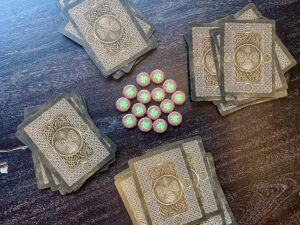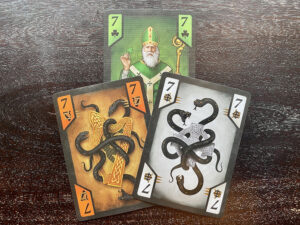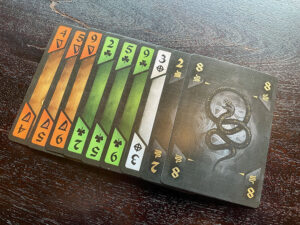 Trick-taking games have taken the card gaming world by storm in recent years. The now classic mechanism of favored suits taking hands of cards has been adapted many times over. Typically, these systems involve players either following or not following suit with any number of unique layers added on to enhance the theme or provide a clever puzzle.
Trick-taking games have taken the card gaming world by storm in recent years. The now classic mechanism of favored suits taking hands of cards has been adapted many times over. Typically, these systems involve players either following or not following suit with any number of unique layers added on to enhance the theme or provide a clever puzzle.
St. Patrick is a new trick-taking game for three to four players, designed by Haig Tahta and Sacha Tahta Alexander, and published by Matagot. It utilizes a must-follow system and adds new wrinkles to the classic round structure seen in other games in the genre. It’s themed around the lore of the titular historical figure and the banishment of snakes.
Gameplay Overview:
In St. Patrick players begin with twenty health and must avoid taking snake cards during trick taking so their health does not deplete to zero. There are three phases to each round of play and the deck of cards is made up of four suits: clover (green), cross (white), harp (orange), and snake (black). There are also snakes on the white and orange seven cards.

In phase one, all cards are dealt, and fifteen relic tokens are added to the middle of the table. Before moving on from this phase, players pass cards to their left as dictated by the player with the least amount of health. This can be from zero to two cards, though if there is a tie with health then this defaults to one card.
Phase two is about protection. The relic tokens provide defense against snake bites during phase three. Players analyze their hand of cards and either take a certain number of relic tokens or pass. This phase ends once players have passed or all relics are taken. Players move on to the next phase if there are still relics on the table. Otherwise, the players collective greed causes them to return all relics and pass their full hand of cards to the player on their left.
The relic phase can cause considerable damage to players and is a bit of a push-your-luck element. If all relics are taken, each player suffers damage equal to the number of tokens they’ve taken. As such, finding the balance between snake protection and greed is crucial. It must also be noted that players are not penalized for over-protecting themselves.
The final phase is called the snake hunt. Starting with the player holding the green seven card (St. Patrick), players engage in must-follow trick-taking, trying to avoid the black suit (snakes) as well as the orange and white sevens. Players can take up to their relic token amount without being damaged. It also must be noted that the white and orange snake cards inflict three damage instead of the normal one damage, making them especially dangerous.

Game Experience:
St. Patrick has a couple of intriguing twists on the standard trick-taking genre. The relic phase is most notable, as it creates a way for players to push their luck for protection, as well as take damage just to pass off a bad hand of cards. The agency included with this phase creates some unique gameplay moments, but ultimately something is missing from the relic phase.

While the agency during this phase is great, the game’s system does nothing to punish players who’ve been too greedy with their acquisitions. Players may have to take relics they don’t need just to force an empty pot, which then causes them to lose their hand to another player. In the BGG forums, the designers have commented on the fact that punishing players for taking more relics than needed adds a luck element, but there is an odd disconnect during this phase.
To add to this, there is a special snake hunt that occurs when the relic pot continues to be emptied until players receive their original hand of cards back. The rules ask players to suffer damage as normal and then play the round for fun, but they can also gain back life based on taking equal or fewer snakes compared to their relics.
I would’ve much rather seen a full reset at this point, rather than a wasted round and a potential one life point in return. This is also confusing as the game length can be rather long if players are conservative with taking relics and don’t suffer a lot of damage each round. Many trick taking games have rounds equal to the number of players at the table, but here the length goes beyond that.

The highlight here is the inclusion of snake cards in different suits. While the green seven is safe, the white and orange sevens and their three damage create a lot of tension. It’s great how these two cards can dictate so much. Thankfully there’s also an option to take on all the snake cards in a move called the big sacrifice. In this rare situation, all other players suffer three shame damage, and this shame cannot be negated by the relics.
Another highlight of the design happens during phase one, where the player with the most damage can determine how many cards to pass to the left. It provides a way to even the playing field, while also taking a risk on which cards will be received. This is especially helpful if you have a hand of cards that may be more conducive to the big sacrifice and shaming your opponents.
The illustration (by Bastien Jez) and the snake gold foiling on the cards are nice. The art on the cards does a great job of invoking Irish culture. But I’m not a fan of the theme. While it’s commenting on lore from the fifth century, it doesn’t take much to discover that the true snakes that St. Patrick drove away from the land were those individuals who did not agree with his faith. A simple online search illuminates a lot about this figure and joining him on this mission may be something the socially conscious may prefer to keep at arm’s length.
Final Thoughts:
Do you want to hunt the serpents out of Ireland? Then St. Patrick is for you. Unfortunate theming aside, the mechanisms provide a new tweak to the trick-taking genre. I did feel that there’s potential for refinement, most notably with the relic phase and the quest for tokens. Even with all my quibbles with the design, there are certainly highlights, though the game length compared to others with similar ambitions will probably force this to leave my island of games sooner than later. You know, the St. Patrick way.
Final Score: 3 stars – Interesting twists on trick-taking that suffer from certain snakebites.
 Hits:
Hits:
• Inclusion of suit-specific snakes
• Passing cards determined by last player
• Excellent illustration and gold foiling
Misses:
• St. Patrick theme
• Relic phase woes
• Game length






















